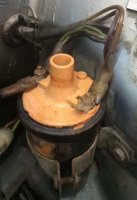As I was reading the installation instructions for my Pertronix 1867 into my carbed cs, I noticed they recommended hooking the red wire to the positive of the coil with the resistor in between. Now my car is a 74 and therefore does not have a ballast resistor but a wire resistor instead. Only problem is, I can't find where that wire is... I have what appears to be a black original coil although the part number on the bottom is a bit odd. It is 0221 119 C17. But that C is backwards. See photo. I would think it is supposed to be a 0 and the stamp did not print it clearly but it really looks like it is a backwards C and not a 0.
So what coil would this be? Is it the original black one?
If so, I believe it is supposed to use a resistor. However the Pertronix instructions say that the coil needs to have minimum of 1.5 ohm resistance. When I measure it, it gives me about 2.0 ohms across the + and - without any wires attached. Does that mean that I can safely attach the red wire from the Pertronix directly to the positive of the coil, regardless of where the resistor wire is?
Thank you
So what coil would this be? Is it the original black one?
If so, I believe it is supposed to use a resistor. However the Pertronix instructions say that the coil needs to have minimum of 1.5 ohm resistance. When I measure it, it gives me about 2.0 ohms across the + and - without any wires attached. Does that mean that I can safely attach the red wire from the Pertronix directly to the positive of the coil, regardless of where the resistor wire is?
Thank you




